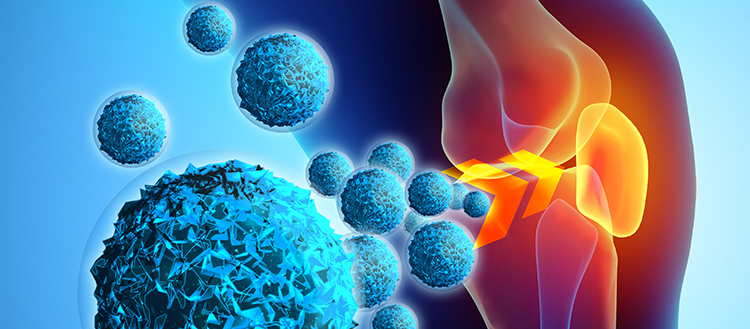Nano and micro join forces to treat osteoarthritis
Microparticles loaded with nanocrystals and a smart nanogel: UNIGE researchers are exploring new types of treatment that can protect joint cartilage – and even reverse the course of osteoarthritis.

Thanks to nanocrystals encapsulated in microparticles, researchers from UNIGE hope to improve the existing treatments. © UNIGE/istock
There is currently no treatment for curing osteoarthritis, which affects 80% of the population over 75 years of age. The only possibility is to give patients medication to relieve the inflammation and slow the progress of this degenerative disease. But researchers at the University of Geneva (UNIGE) who have been studying the problem have come up with a new treatment that delivers previously-identified active principles directly into the joint in the form of nanocrystals inserted into microparticles. The localised injection of vectors might not only stabilise the disease but could even reverse it! The UNIGE research has been the subject of a series of four articles in Drug Discovery Today, Small, the Journal of Controlled Release and Nanoscale. The work has also led to a new patent that is now being held by KYLYS, a UNIGE start-up.
Osteoarthritis is very common in the elderly, and the fact that the disease progresses very slowly hinders the development of new therapies. In fact, the outcomes of clinical trials can take years, a timescale that is often prohibitive for pharmaceutical companies setting their R&D priorities – which is why the UNIGE researchers decided to investigate the problem, focusing in particular on molecules that had already been clinically tested.
The search for a more effective and better-tolerated treatment
«Our strategy has been to take a second look at molecules that had been excluded by clinical trials due to their side effects,» explains Eric Allémann, full professor and recently appointed president of the pharmaceutical sciences section in UNIGE’s Science Faculty. «These compounds, which were administered orally, distributed and diffused throughout the body with only a very small fraction of it acting on the joint. But, by delivering the active principle exactly where we want to, we can drastically reduce the amount needed and avoid side effects.»
In more concrete terms, the UNIGE researchers focused their efforts on kartogenin – a molecule capable of regenerating cartilage – encapsulated in the form of nanocrystals in microparticles. With a diameter of 10 micrometers, these microparticles are made up of biodegradable polymer and can be easily administered by intra-articular injection. The treatment stays in place in the knee for several months, progressively delivering the kartogenin that helps rebuild the cartilage. «The aim isn’t only to stabilise the joint but also to make it fully functional again», declares Pierre Maudens, post-doctoral fellow in the pharmaceutical sciences section and the first author of the four articles. The nanocrystals, which are wrapped in microparticles, can then be used to deliver the active principle over very extended periods without causing any inflammation – and even reversing the course of the disease, as suggested by the treatments conducted on mice.
A smart nanogel
The current treatment for osteoarthritis is based on several stages that consist of controlling the disease rather than curing it. Physiotherapy, which gets the patient moving, is the first step, followed by the prescription of anti-inflammatory drugs and then, before resorting to surgery, a hyaluronic acid (HA) injection. This is not a drug as such but a medical device, a natural lubricant available as a gel that helps relieve pain although it has no actual therapeutic effect.
The UNIGE researchers also examined the HA, which degrades very quickly due to the enzymes secreted by the body. By modifying its polymer chains so that it self assembled in the form of nanoparticles rather than a gel at body temperature, the scientists were able to alter some of its characteristics. «It no longer behaves like a simple lubricant but more like a biocompatible ball-bearing that stays in place in the knee, because enzymes secreted by the body don’t manage to degrade this new polymer system,» says Olivier Jordan, a senior lecturer in UNIGE’s pharmaceutical sciences section and co-founder of KYLYS, the company which owns the patent filed on a discovery that has been dubbed «HA Pearls». HA Pearls – in the form of nanoparticles – can act for several months in the joint, compared to only a handful of days for HA. All-in-all, it is a highly promising breakthrough that will significantly reduce the injections needed for treating osteoarthritis and thereby improve the quality of life of patients.
16 Jul 2018